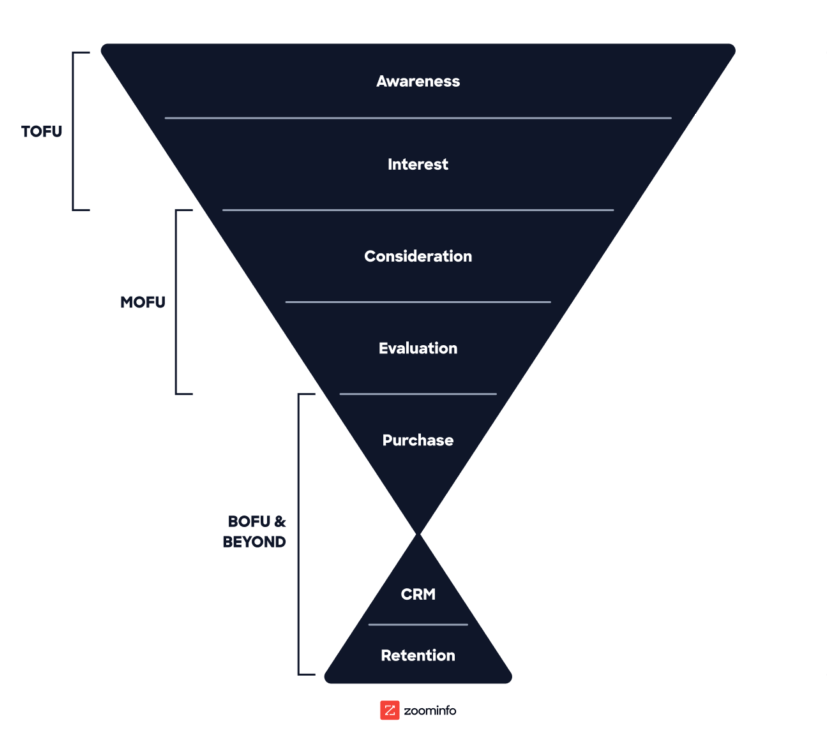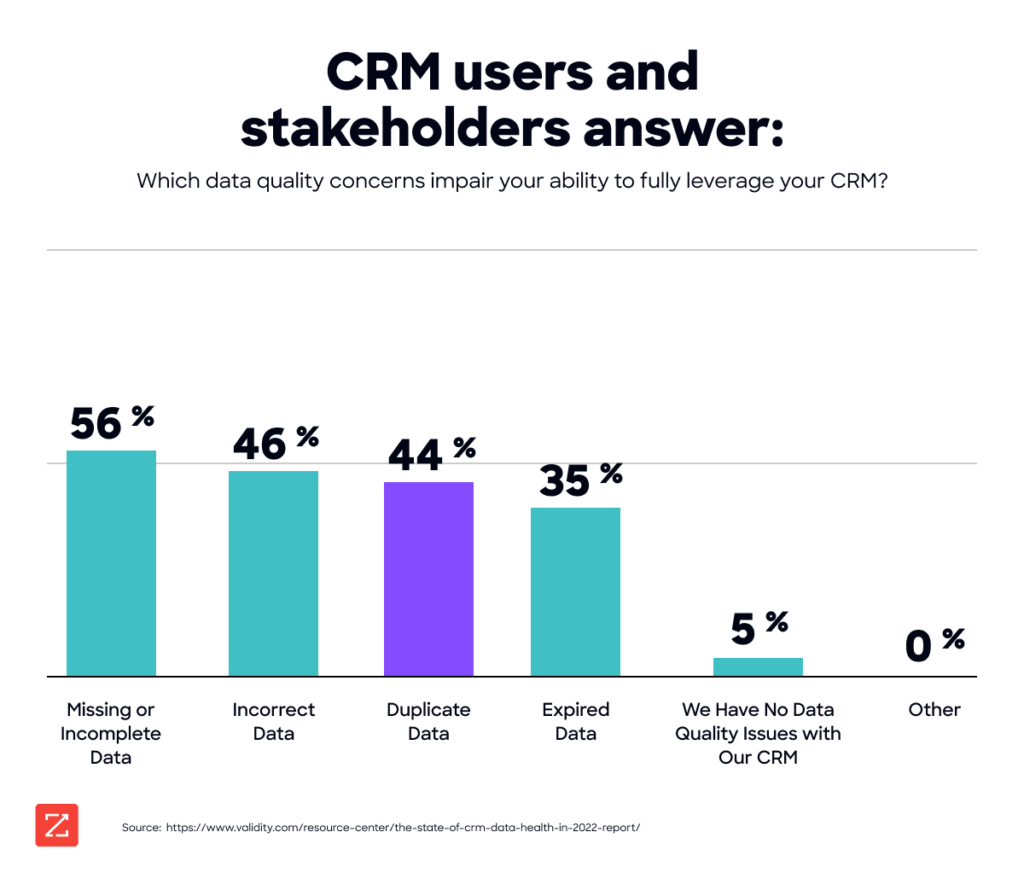Right now, your company’s ideal prospects are researching the products and services that could solve their problems. Hopefully, they’re on your website, viewing your blog posts, videos, and case studies.
What’s the key to attracting and qualifying those ideal B2B prospects? It starts with a well-designed sales funnel.
What Is a B2B Sales Funnel?
The B2B sales funnel defines the stages in which prospective customers move through the buying process. Salespeople interact with prospects at each stage, persuading them to make a purchase.
The funnel has four parts: top, middle, bottom, and post-funnel.

Top of the funnel (TOFU): At the broadest part of the funnel, prospects interact with your content. That might include watching product videos, skimming blog posts, or listening to your podcast.
Middle of the funnel (MOFU): Here, prospects might download a content asset, sign up for a webinar, or visit a link that’s been sent to them via email or display ad targeting. Their contact information goes into the CRM, and a salesperson gets the most promising prospects on the phone.
Bottom of the funnel (BOFU): The funnel narrows, guiding leads toward a purchase. A sales rep demos a product, and follows up; leads buy the product and leave the funnel (or reenter the sales cycle) as new customers.
Post-funnel: What happens when a lead exits the bottom of the funnel and becomes a customer? They enter the post-funnel space. Here, existing customers become new leads for repeat sales.
Ultimately, the success of a sales funnel depends on a rep’s ability to engage with potential buyers.
B2B Marketing Funnel vs. B2B Sales Funnel
Both key parts of a go-to-market team rely on the funnel concept to target their efforts at the right moments in the buyer’s journey. The two concepts and the tactics associated with them have significant overlap, depending on the maturity of a company’s GTM motions.
In companies where the GTM teams are very well aligned, the B2B marketing funnel and sales funnel are essentially the same — no daylight between sales and marketing teams.
In other cases, marketing is qualifying leads to deliver to sales, while sales is also prospecting and generating business to qualify and convert — in those cases, the funnels intersect at key moments of lead qualification.
However they’re constructed, it’s important to regularly reassess the connections and friction between sales and marketing motions, and tweak or overhaul how your funnels are built and activated, to get the best results.
How the B2B Sales Funnel Differs From B2C
For sales professionals with a B2C background, understanding the B2B funnel requires a shift in mindset.
While consumers tend to be relatively impulsive, B2B leads are generally rational and considered. Major purchase decisions are rarely made without plenty of internal debate, and the signatures of senior executives.
The most effective funnels are built to nurture, rather than sell fast. Progress is moving a lead to the next stage, rather than closing a deal quickly.
B2B sales needs different content, too. Leads are generally most interested in educational content that addresses their problems, and provides expert insight. In the later stages of the buyer’s journey, content that allows champions to make the case for your solution is very valuable.
How to Build a B2B Sales Funnel
To build an effective sales funnel, you must understand the stages of your customer’s buying decision. Start selling too early, and you risk irritating the customer and losing the sale.
Conversely, if you don’t guide the sales process to show prospects how your product solves their problem, they won’t understand its value, and become more likely to bail.
Create a human connection at each point, providing personalized content and support with every interaction.
1. Awareness Stage
In the awareness stage, your prospect has started to identify the business problem they need to solve. They’re likely researching options across the web and leaning on their personal networks for recommendations and ideas.
Sales reps can gather information about prospects in this stage via first-party data, such as their activity on your website — the pages they visited and how long they stayed.
Additionally, third-party intent data can help fill in more details about a company’s interest levels, filling in details about a prospect account’s activity across the broader web and any proprietary insights gathered through dedicated prospect research.
With this information, sales can understand the prospect’s needs, show them related content, and move them to the next stage.
2. Interest Stage
During the interest stage, prospects dig deeper into your brand to determine if your product is a good fit. Good content can make a big impact here and guide their decision.
Prospects might register for a webinar, download an eBook, or interact with content that’s being targeted toward them via email, paid social, and display ad campaigns. These channels are a good way to pull qualified leads into your marketing funnel.
Alternatively, your sales rep might make first contact via email or a phone call. If so, they must go in prepared. That includes taking the time to personalize the interaction to build a relationship with the prospective buyer.
With instant access to buyer information and industry news and events, reps can shape these early interactions to fit buyers’ needs — such as acknowledging specific industry changes or asking about their existing tech stack.
3. Consideration Stage
During consideration, the lead is ready to see how your product works and whether it will fit their needs. They might request a demo now, or in the next stage of the customer journey.
Reps should have a clear understanding of the lead’s business during the consideration stage, and be able to demonstrate how your product will solve their problem.
It’s taken a lot of work to get the buyer to this point. Your data will play an essential role in moving the qualified sales lead toward a deal.
Tip: Ask about decision-makers. Is there more than one? Use buying signals to track who’s interacting with your content by company and title. This intel will help steer the conversation toward the people making buying decisions.
4. Decision Stage
After many touchpoints, the lead has to make a purchase decision. This may involve a number of internal discussions, where champions within the business make their final case to stakeholders.
At this point, reinforcing trust between the salesperson and the lead is indispensable.
Experienced reps should be familiar with the most common sales objections during the decision stage, and know how to address concerns as they come up.
With access to comparison data, specification sheets, and customer success stories, the salesperson can show buyers the product’s value and put any doubts to rest.
Here’s where the funnel pays off: with proper care and a well-tuned sales process, qualified leads become closed-won accounts. But the funnel isn’t done — customers can churn, or become valuable cross-sell and upsell opportunities, depending on how a company handles the relationship.
5. Post-Sale Stage
Once your prospect is a customer, a new team likely takes over onboarding, implementation, training, and account health.
It’s critical to consider customer experience as a part of the overall sales flywheel — without recurring and growing revenue, a B2B sales funnel will have a hard time keeping up with costly churn from hard-won customers.
Pay attention to key signals such as seat usage, product reviews, and NPS results to ensure customers are satisfied — and seek to identify new areas of the business that could benefit from your products and services, now that you have an internal champion who can help expand your beachhead.
How to Optimize Your B2B Sales Funnel
You have a sales funnel to guide the selling process. Now, you will need to optimize it.
Define Your Big-Picture Goals
Before making structural changes to your funnel, identify and define why you’re altering your marketing strategy.
Work backward from your long-term, big-picture goals. Pinpoint the processes and funnel stages derailing your ambitions. Consider how they might be improved.
Map Out Your Ideal Customer Profiles (ICPs)
Your ideal customer profile defines your most valuable buyers. Those potential customers should be at the core of your optimization efforts.
As you reshape your B2B sales cycle, think about what’s best for your ICPs.
For example, by combining ideal firmographic and technographic data, sales and marketing can collaboratively ensure that target prospects see the right content at the right time.
Similarly, aim your sales pitch solely at ICPs. Don’t worry if other, less qualified leads fall away. Focus on the data relating to your ideal buyers.
Cleanse Your CRM
In theory, your customer relationship management (CRM) solution should organize and automate sales processes, so that reps can focus on selling.
However, your CRM is only as good as its data. A database containing too many incomplete and inaccurate records holds your sales representatives back and wastes time.

Data cleansing is a key part of B2B funnel optimization. Consider running a full data quality audit, and scrutinize how data is used throughout the funnel.
Align Marketing and Sales Teams
Since the B2B funnel will eventually require a hand-off from marketing to sales, sales and marketing teams need to be properly aligned.
Fumbled handovers are often caused by poor data handling. Sales professionals need to clearly understand who they’re talking to, and marketing campaigns must be structured to collect key information.
When data access is the primary problem, switching to a fully integrated sales and marketing solution can fix the issue.
Identify Your Best Sales Channels
Through which channels are you most likely to reach your buyer personas?
Narrow down the selection to one or two main avenues. To improve funnel efficiency, consider specializing here.
Focusing on specific channels ensures that you provide an excellent customer experience throughout the buyer’s journey.
Create Content for Each Stage of the Funnel
The B2B sales funnel model is based on content. Understanding what your prospects want to hear at each stage is mandatory for optimizing your funnel.
Leaders should take action on this analysis, and commission unique content for each stage.
Beware of repetition. Whether it’s social media marketing or long-form educational content, recycling content from one stage to another usually means reducing their real-world value.
Think About Post-Purchase Engagement
The B2B sales journey rarely ends with the initial purchase. Current customers make great prospects, if you can attract them back into the funnel.
Look at how you can keep customers engaged in the months and years after that first purchase. Consider revising your funnel to take these opportunities into account.
Embrace Automation
The process of funnel optimization creates quite a task list, and many tasks need to be repeated frequently to maximize efficiency.
Realistically, the only way that most businesses can cover all their bases is automation.
Today, the most advanced automation is employing artificial intelligence (AI) to recommend who to contact, when to engage, and even how to address them across sales and marketing channels.
Follow the Data
Some of the most important data points to watch include:
Conversion rate by channel
Customer acquisition cost/return on investment
Customer loyalty metrics
Set Up Your B2B Sales Funnel for More Wins
The sales funnel only represents the average buyer’s journey. Reality is messy, with leads emerging and evaporating throughout different stages of the funnel.
Setting up your funnel to provide a clear direction is still important. If leads are generally moving through the stages, there’s a good chance you will start closing more deals.


